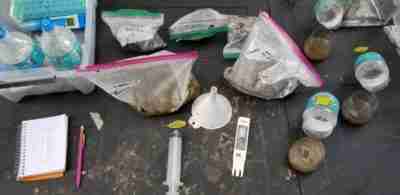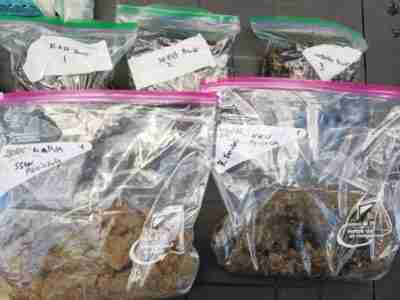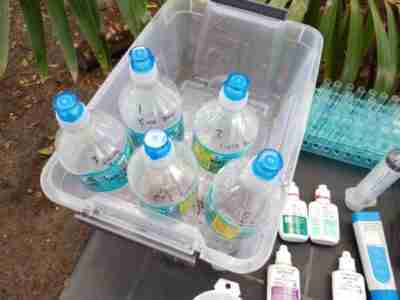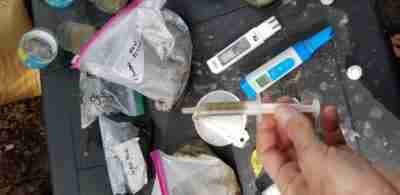 Biotope data information is very important and can be very useful to hobbyists. Biotope Data taken accurately from collection sites can give a lot of insight to hobbyists and help them further their hobby. Simply download the form here and fill it out digitally or print it out. Email it to us and we add it. Easy.
Biotope data information is very important and can be very useful to hobbyists. Biotope Data taken accurately from collection sites can give a lot of insight to hobbyists and help them further their hobby. Simply download the form here and fill it out digitally or print it out. Email it to us and we add it. Easy.
Many species that we keep today, even some more common ones, we still know little about. More information could be the very thing we need to complete the picture for proper husbandry in aquarium and terrarium hobby. You could easily be one supplying information to other fellow hobbyists.
This collected data will allow each entry to have details about the parameters necessary for successful aquarium and terrarium keepers. It is quite possible your data could be the thing that creates successful conditions for a hard to breed species.
Articles created from these entries will give information about hardscape, substrate, plants, lighting, and tankmates for each location and type. Other compatible species like fish, plants, and invertebrates will also be listed so you can make well-informed decisions about tankmates for their health and your maximum enjoyment.
Photos of the whole biotope site will help create healthy enclosures. Photos of soil studies will also be accompanied by soil and water pH readings, soil and water temperatures, and soil and water pH parameters to recreate each collection point to the best possible detail. Other information about each habitat will include environmental details, local culture and sights, and ecological outlooks of the general area.
We need to save as much data as possible about our global habitats before it’s gone. This is a great way to do it and there’s no paywall to the information! It’s available on the website without memberships or having to pay for apps or the data.
Collecting Data Can Benefit Commonly Kept Species Too
With beetle specimen collecting, for instance, many insects are captured from the wild and pinned to a board to be dried and added to a collector’s displays. Many beetles can only be wild collected because we simply don’t know how they breed or what requirements their larvae need to develop. This type of incomplete data also applies to tree frogs, fish, shrimp, and even some plants.
Understanding more about these species can help us breed them in captivity better. This can help spare species from complete extinction, we know already that hobbyists are responsible for keeping many species from being completely extinct.
Soil Samples

For soil samples, in most cases, taking two separate samples from the organic litter/humus layer and the inorganic deeper layers should be sufficient. Soil pH is important as is the organic and mineral makeup, the type of leaf litter, height, and type of vegetation, and direction vegetation is growing.
Document the soil composition visually. If possible take a soil horizon photo of 50cm depth (18 inches deep). Soil composition shown through a cutaway or side view picture can come in handy when designing enclosures as well as being biologically beneficial to the flora and fauna we keep. Some areas we cannot dig a hole or do not want to dig a hole so a piece of pipe can take a section sample.
In this matter, a piece of 1-inch PVC pipe can be used. Cut one end at a 45-degree angle and sharpen the outer diameter. Push or hammer it into the ground and use a stick or push rod to push the soil out of the tube onto white paper so that it can be photographed. Disturb the soil as little as possible for the initial photo. Spreading the soil out more in following pictures can help give us a better idea of what the soil is made of and how well it is packed and how well it may drain.
Data such as water and soil temperature, water and soil pH, nitrogen, potassium, and phosphate levels, TDS (total dissolved solids), can greatly increase the health of kept specimens. Even though we keep many animals and plants they could be further advanced with more data.
Soil and Water PH
 Soil and water pH is an important parameter if you can get it. Many plants uptake nutrients best at 5.6 pH, but some do not. Many plants have adapted to harsh conditions and need higher or lower pH to thrive. Knowing these values can help us cultivate them better.
Soil and water pH is an important parameter if you can get it. Many plants uptake nutrients best at 5.6 pH, but some do not. Many plants have adapted to harsh conditions and need higher or lower pH to thrive. Knowing these values can help us cultivate them better.
Soil pH can be collected with a pH probe with soil spike, simple soil PH test kits, or by extracting and testing the soils pore water via liquid or strip test kit. Liquid reagents are preferred and are more accurate but paper strips will give us a better idea than guessing.
Knowing this type of data can make building our enclosures easier and better suited to our target species. Plants and animals alike can benefit from the proper pH range of soil and water.
Soil and Water Temperature
Soil temperature can be taken via infrared thermometer, from weather data, or an old fashioned thermometer. Water temperatures need to be read with a good thermometer at everal depths. Water temperature depends on many factors such as color, flow, forest canopy, and its source. Knowing water temperature is very important, especially to fish keepers. Most people assume that tropical fish are 68 to 78 degrees but this is not always the case.
Taking soil parameters
A series of samples (3 to 5 from each location) should be collected from your area of study. If it is a body of water and it’s possible, take a sample from the North, East, South, and West banks, or from perpendicular/opposing banks. Each sample should be tested a minimum of 2 times to ensure the accuracy of your reading. Pore water samples can give us a lot of useful information to help plants and animal species thrive.
Pore Water Extraction For Soil and Substrate Samples
 To extract the soils pore water you will need the following:
To extract the soils pore water you will need the following:
Clean cloth or 300-micron mesh filter bag.
Clean glass test vials.
Water testing kit (Nutrafin, Lamott, and Sera test kits will give the most accurate readings).
To extract the pore water simply place your soil sample in the cloth or mesh bag and squeeze the water from the soil. You will need 10 to 20 milliliters of pore water to test. Be sure to rinse your cloth with clean neutral water in-between each sample to prevent cross contamination.
This pore water can now be tested for whatever parameter you are searching for. Liquid reagents are better for accuracy but test strips can be used as well. PH, Po4, KNO3, Iron, and other values can be tested. Knowing these simple details that are quickly collected can make huge strides in the success of hobbyists animal husbandry.
Learn More and Collect More Data
 Knowing more about the habitat from where our flora and fauna originate can be a huge help in our husbandry of these species. Hopefully, we can collect data and piece together information to benefit hobbyists in their pursuit of keeping flora and fauna. We still don’t know a lot about some species, but slowly we are finding out more and more. This is a great way to know more and also help save threatened species.
Knowing more about the habitat from where our flora and fauna originate can be a huge help in our husbandry of these species. Hopefully, we can collect data and piece together information to benefit hobbyists in their pursuit of keeping flora and fauna. We still don’t know a lot about some species, but slowly we are finding out more and more. This is a great way to know more and also help save threatened species.
There are data collection sheets available at Biotope One for you to print out, and a PDF version you can fill out online to submit to us for publication and sharing. If you live in a location or will travel to a location take along a printed Data Collection sheet and document the exact location, parameters, and details.
We will enter it into the project for everyone to access and use. The few minutes it takes to collect data could be the key to success that we have been locked out of. You will be given credit for your contributions and you will be helping forward the hobby.
Always respect the environment and avoid destroying habitat. Some areas it isn’t adviseable to dig into the ground to get a photo of the soil. Use common sense when collecting data. Also avoid trampling plants and animals while in the field.
If you have any questions please contact one of us and we will answer any questions you may have. Email your information to Chantz Cramer at Chantz*BiotopeOne*com or myself at Info*BiotopeOne*com and we will add it to the project.
by Chantz Cramer
 Biotope One A Study of Flora and Fauna
Biotope One A Study of Flora and Fauna 


